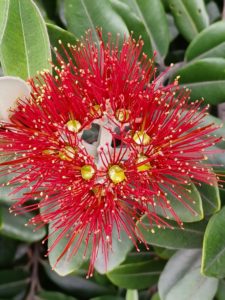The Pohutukawa Flower – Out of the cross comes light and life…

Usually, when I see a Pohutukawa flower, I see it from underneath the branches or from a distance. Then, it appears like a little round brush, like a knob, or a pompom on top of a beanie.
Once you get closer, you realise that the ‘pompom’ is made of very delicate, thin stamens – with tiny golden tips. This year, I looked more closely at some Pohutukawa – a fascinating experience.
I am not a flora expert and so I can only refer to the blossoms I have looked at.
The trees, or better the shrubs, are usually located close to the beaches in the Northern and Eastern part of New Zealand. During most of the year, you see them and yet don’t really notice them. They are there, they are said to give strength and stability to the ground on which they grow. They give shelter from wind and sun – but they are often taken for granted.
As an immigrant to Aotearoa New Zealand, you first think that it is one of the beautiful evergreen trees….
The surprise comes when it gets closer to Christmas. In November or December, the Pohutukawa start to show their beauty. There is a reason why Pohutukawa are sacred according to Māori traditions and why the first settlers called them ‘Christmas Trees’.
The flower is amazing. On the picture, you can see how symmetrically the petals have grown around a shallow bowl of nectar.
It seems like the centre is formed as a cross out of which these beautiful red petals emerge. The shiny nectar is nutrition and life for the bees – we usually don’t even see it. What we do see are the tips of the petals. They shimmer like golden dust…
While the climate at Christmas time in Aotearoa New Zealand is so different to the Northern Hemisphere, the Pohutukawa embraces the symbols and colours of Christmas known to us Europeans:
- Green – the colour of Hope
Jesus’ birth gives us hope for our lives – as conifers, green trees in winter time, give hope when other trees have lost their leaves. - Red – the colour of Love and Life
God loves us so much that he sent his son to be with us, “the Word was made flesh and lived among us’ – red is the colour of blood which is necessary for us to live - Gold – the colour of Light and Life
Jesus said that he was the ‘Light of the World’ – the Christmas candles on the tree, in the houses and churches shed light into the dark season of the Northern Hemisphere.
The birth of a child brings light into our lives.
I think that the settlers were right – this is a true Christmas tree, a gift from God.
We know that Christianity started with the Cross, the death of Jesus. Christmas and the Infancy Narratives are only mentioned in two of the four Gospels. All Gospels mention Jesus’ death on the Cross. This is the starting point for us.
The picture of the Pohutukawa shows that this flower also started with the Cross in the centre of the flower: the Cross, the wounds, the life that was given for us and life as a gift from God to us – and the radiant petals with the golden tips to remind us to spread the Good News.
Out of the cross comes light and life…
How did Maori think about this interpretation when the Europeans settled in their lands?
According to Māori mythology, the mythical hero Tawhaki fell to his death from the sky – and the Pohutukawa flowers represent his blood.
The Pohutukawa is also connected to Cape Reinga from where the spirits of the dead pass on their way to the next world.
Spirit, blood and life – and the connection between Heaven and Earth. A truly sacred tree.
Let us protect the Pohutukawa from possums and cutting so that many future generations can experience the wonder of the Pohutukawa blossom for Christmas.
BM



